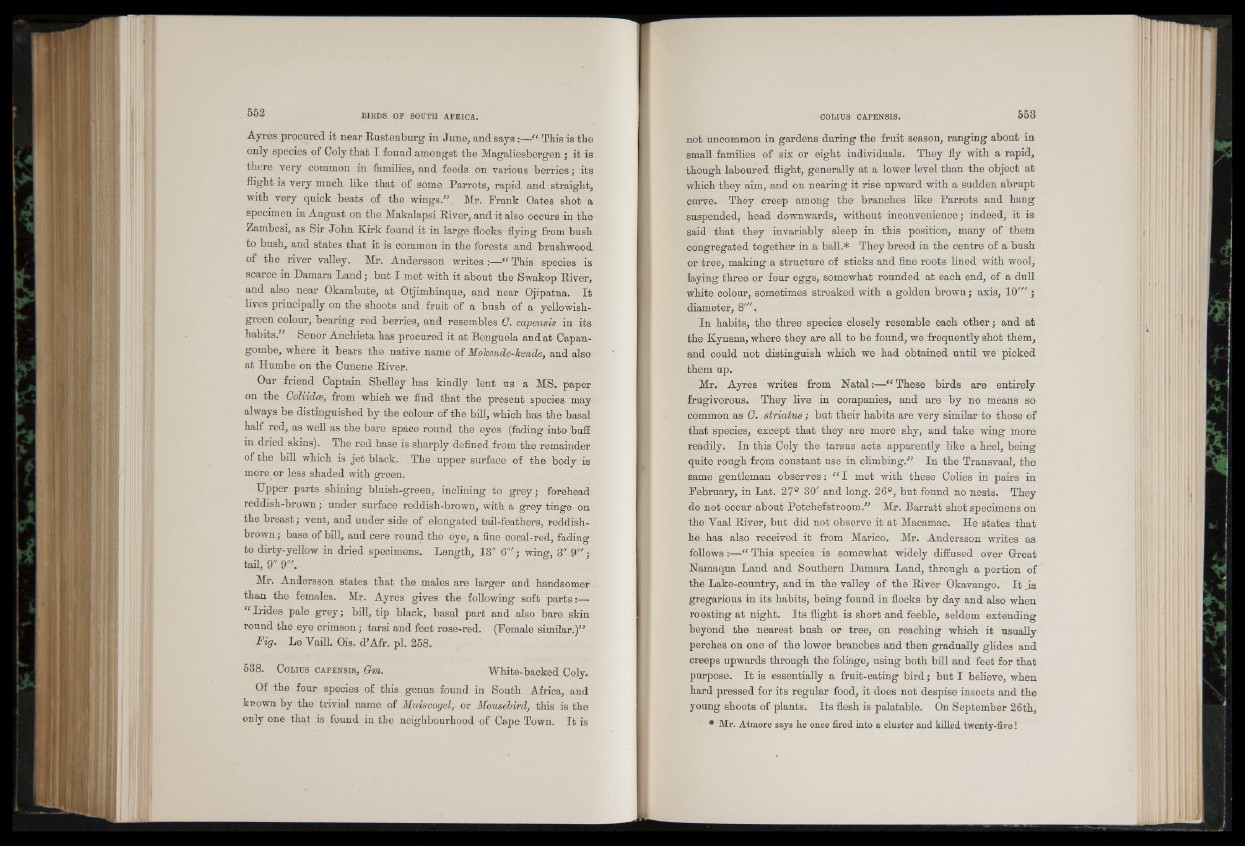
Ayres procured it near Rustenburg in June, and says :—“ This is the
only species of Coly that I found amongst the Magaliesbergen ; it is
there very common in families, and feeds on various berries; its
flight is very much like that of some Parrots, rapid and straight,
with very quick beats of the wings.” Mr. Prank Oates shot a
specimen in August on the Makalapsi River, and it also occurs in the
Zambesi, as Sir John Kirk found it in large flocks flying from bush
to bush, and states that it is common in the forests and brushwood
of the river valley. Mr. Andersson writes :—“ This species is
scarce in Damara Land; but X met with it about the Swakop River,
and also near Okambute, at Otjimbinque, and near Ojipatna. It
lives principally on the shoots and fruit of a bush of a- yellowish-
green colour, bearing red berries, and resembles C. capensis in its
habits.” Senor Anchieta has procured it at Benguela and at Capan-
gombe, where it bears the native name of Mohende-kende, and also
at Humbe on the Cunene River.
Our friend Captain Shelley has kindly lent us a MS. paper
on the Goliid(B, from which we find that the present species may
always be distinguished by the colour of the bill, which has the basal
half red, as well as the bare space round the eyes (fading into buff
in dried skins). The red base is sharply defined from the remainder
of the bill which is jet black. The upper surface of the body is
more or less shaded with green.
Upper parts shining bluish-green, inclining to grey; forehead
reddish-brown; under surface reddish-brown, with a grey tinge on
the breast; vent, and under side of elongated tail-feathers, reddish-
brown ; base of bill, and cere round the eye, a fine coral-red, fading
to dirty-yellow in dried specimens. Length, 13" 6"'; wing, 3" 9"';
tail, 9" 9'".
Mr. Andersson states that the males are larger and handsomer
than the females. Mr. Ayres gives the following soft parts:—
“ Irides pale grey; bill, tip black, basal part and also bare skin
round the eye crimson; tarsi and feet rose-red. (Female similar.)”
Fig. Le Yaill. Ois. d’Afr. pi. 258.
538. Couus c apensis , Gm. White-backed Coly.
Of the four species of this genus found in South Africa, and
known by the trivial name of Muisvogel, or Mousebird, this is the
only one that is found in the neighbourhood of Cape Town. It is
not uncommon in gardens during the fruit season, ranging about in
small families of six or eight individuals. They fly with a rapid,
though laboured flight, generally at a lower level than the object at
which they aim, and on nearing it rise upward with a sudden abrupt
curve. They creep among the branches like Parrots and hang
suspended, head downwards, without inconvenience; indeed, it is
said that they invariably sleep in this position, many of them
congregated together in a ball.* They breed in the centre of a bush
or tree, making a structure of sticks and fine roots lined with wool,
laying three or four eggs, somewhat rounded at each end, of a dull
white colour, sometimes streaked with a golden brown; axis, 10 ”' ;
diameter, S'".
In habits, the three species closely resemble each other; and at
the Kynsna, where they are all to be found, we frequently shot them,
and could not distinguish which we had obtained until we picked
them up.
Mr. Ayres writes from Natal:—“ These birds are entirely
frugivorous. They live in companies, and are by no means so
common as 0. striatus ; but their habits are very similar to those of
that species, except that they are more shy, and take wing more
readily. In this Coly the tarsus acts apparently like a heel, being
quite rough from constant use in climbing.” In the Transvaal, the
same gentleman observes: “ I met with these Colies in pairs in
February, in Lat. 27° 30' and long. 26°, but found no nests. They
do not occur about Potchefstroom.” Mr. Barratt shot specimens on
the Yaal River, but did not observe it at Macamac. He states that
he has also received it from Marico. Mr. Andersson writes as
follows:—“ This species is somewhat widely diffused over Great
Namaqua Land and Southern Damara Land, through a portion of
the Lake-country, and in the valley of the River Okavango. I t _is
gregarious in its habits, being found in flocks by day and also when
roosting at night. Its flight is short and feeble, seldom extending
beyond the nearest bush or tree, on reaching which it usually
perches on one of the lower branches and then gradually glides and
creeps upwards through the foliage, using both bill and feet for that
purpose. It is essentially a fruit-eating bird; but I believe, when
hard pressed for its regular food, it does not despise insects and the
young shoots of plants. Its flesh is palatable. On September 26th,
* Mr. Atmore says he once fired into a cluster and killed twenty-five!